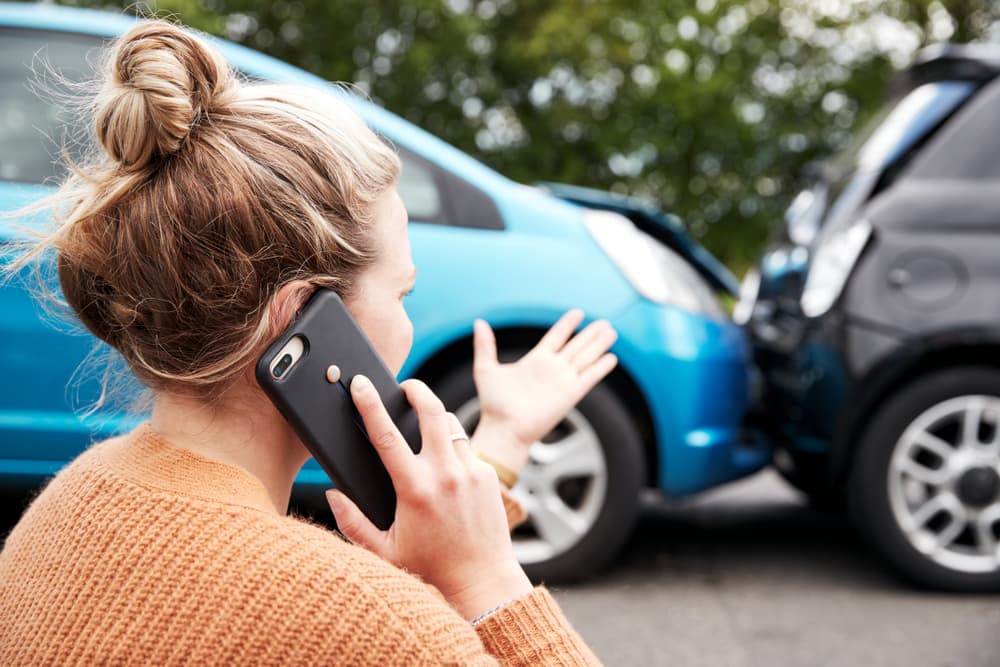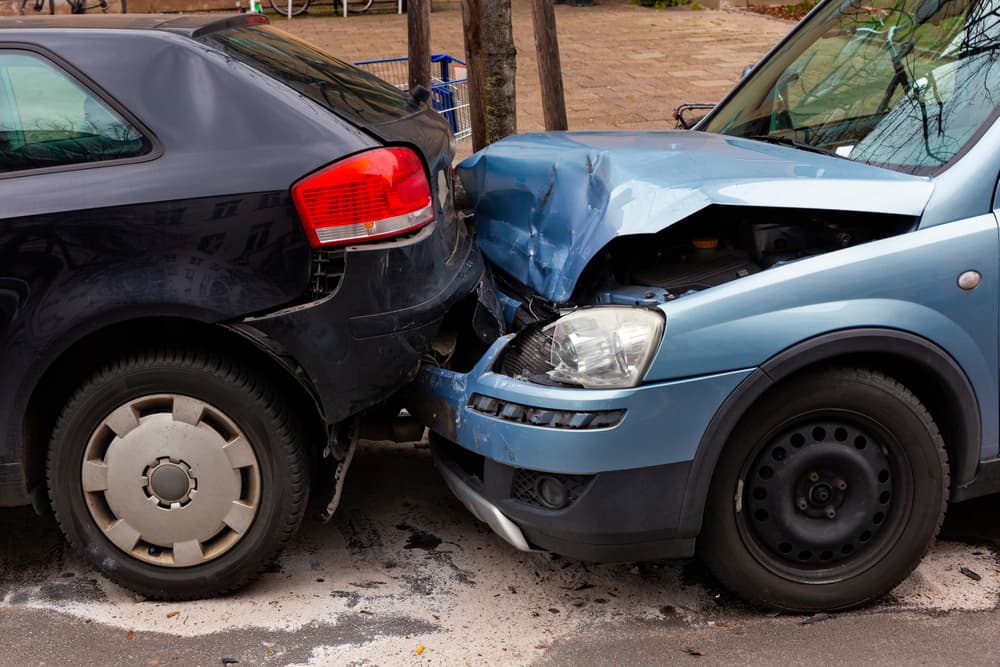Rear-end collisions occur frequently in California and across the United States. Although they’re more common and have a lower fatality rate than other types of vehicle accidents, that does not make them any less serious. A rear-end collision can still cause serious injuries that require extensive medical treatment and rehabilitation.
If you sustained an injury in a rear-end car accident in California and believe the other driver was responsible, you need to understand your rights and options for obtaining compensation for your medical bills, lost income, and other damages. It’s crucial you speak with an experienced car accident attorney near you for advice regarding your best course of action and representation throughout the claims process.
What Causes Rear-End Collisions in California?
Rear-end car accidents occur when one vehicle collides with the back of another. Several factors can contribute to the causes of rear-end collisions, and they often involve a combination of driver behaviors, road conditions, and external factors. Here are some common causes:
- Tailgating: Following too closely is a major contributor to rear-end accidents. If a driver doesn’t leave enough space between their vehicle and the one in front, they may not have enough time to react if the leading vehicle slows down or stops suddenly.
- Sudden Stops: A vehicle suddenly stopping, whether due to traffic conditions, a traffic signal, or an unexpected obstacle, can catch a following driver off guard, leading to a rear-end collision.
- Speeding: Driving at an excessive speed reduces the time available for a driver to react to changing road conditions. Speeding can lead to rear-end collisions, especially in situations where the driver is unable to stop in time.
- Driving Too Slowly: In some cases, a rear-end collision can occur if a driver is driving too slowly. Most interstates and major divided highways have minimum speed limits that vehicles must travel. If a driver can’t maintain the minimum speed, they should use their hazard lights or other means to signal drivers behind them.
- Distracted Driving: Distractions, such as texting, talking on the phone, eating, or adjusting in-car entertainment systems, can divert a driver’s attention from the road. Failing to notice traffic slowing down or coming to a stop is a common consequence of distracted driving.
- Weather Conditions: Adverse weather conditions, such as rain, snow, or ice, can affect road traction and visibility. Slippery roads make it more challenging for drivers to stop in time, increasing the risk of rear-end accidents.
- Impaired Driving: Driving under the influence of alcohol or drugs impairs a driver’s reaction time and judgment, making them more likely to cause a rear-end collision.
- Driver Fatigue: Fatigued or drowsy driving can have similar effects on a driver’s abilities as impaired driving. A tired driver may have slower reaction times and struggle to stay alert to changing road conditions.
- Faulty Brake Lights: If the leading vehicle has malfunctioning brake lights, the following driver may not be adequately informed that the vehicle is slowing down or stopping, increasing the risk of a rear-end collision.
- Aggressive Driving: Aggressive behaviors, such as aggressive tailgating or weaving in and out of traffic, can contribute to rear-end collisions. Aggressive drivers may not anticipate changes in traffic flow.
- Poor Road Conditions: Potholes, uneven road surfaces, or construction zones can create unexpected challenges for drivers. A sudden change in road conditions may lead to a driver being unable to stop in time.
- Illegal U-Turns: Drivers can cause rear-end collisions when they make illegal U-turns and cut off drivers traveling in the opposing lanes of traffic.
- Overtaking or Passing a Vehicle: California drivers must pass vehicles on the left-hand side without “interfering with the safe operation of the overtaken vehicle.” However, drivers can cause rear-end collisions when they try to pass a car in front of them without adequate distance to make the maneuver safely.
How to Determine Fault in a Rear-End Collision

Determining fault in a rear-end collision involves a careful assessment of the circumstances surrounding the accident. While there is a common presumption that the driver of the rear vehicle is at fault, this assumption is not absolute. This presumption can be rebutted with evidence showing the lead driver’s contribution to the accident.
The best way to determine fault for a rear-end collision is to work with an attorney who can gather the necessary evidence to show which driver was acting negligently. Some methods an attorney can use to determine fault include:
- Getting witness statements from anyone who saw the accident. Independent witnesses may provide valuable perspectives on the actions of both drivers and the events surrounding the collision.
- Obtaining a copy of the police report if one was filed. The responding officer’s assessment and documentation of the accident scene and any citations issued can be crucial in determining fault. The police report will also likely contain statements from both drivers involved in the collision. Their accounts of the events leading up to the collision can provide insight into any contributing factors or actions that may have led to the accident.
- Checking for any traffic violations the other driver may have committed, such as speeding, distracted driving, or running a red light. Violations may indicate negligence and contribute to fault determination.
- Assessing the damage to both vehicles. The extent and location of damage can provide clues about the point of impact and the force of the collision, aiding in the determination of fault.
- Examining photos and documentation of the accident scene, including vehicle damage, skid marks, and road conditions. Documenting the scene can help recreate the events leading to the collision.
A car accident attorney can be a valuable resource in helping you determine fault, especially if there’s uncertainty about who caused the wreck or you’re finding it challenging to prove your case.
What Are Common Injuries Associated with Rear-End Collisions?
Rear-end collisions can result in a range of injuries, with the severity often depending on factors such as the speed of the collision, the size of the vehicles involved, and the use of safety measures like seat belts and airbags. Common injuries associated with rear-end collisions include:

Whiplash
Whiplash is one of the most prevalent injuries in rear-end collisions. It occurs when the head is forcefully and abruptly jerked backward and then forward, straining the neck muscles and ligaments. Symptoms may include neck pain, stiffness, headaches, and dizziness.
Head Injuries
The sudden impact of a rear-end collision can lead to head injuries, ranging from mild concussions to more severe traumatic brain injuries (TBIs). Even if there is no direct impact, the jolt from the collision can cause the brain to move within the skull, resulting in injury.
Back Injuries
The force of a rear-end collision can cause various back injuries, including sprains, strains, herniated discs, and fractures. These injuries can result in significant pain, limited mobility, and, in severe cases, long-term disability.
Facial Injuries
Broken glass or impact with the steering wheel or dashboard can cause facial injuries, such as cuts, bruises, fractures, and dental injuries.
Broken Bones
The impact of a rear-end collision can lead to fractures in various parts of the body, including the arms, legs, hands, and ribs. The severity of fractures can vary depending on the circumstances of the collision.
Soft Tissue Injuries
Rear-end accidents can injure muscles, tendons, and ligaments. Soft tissue injuries may result in pain, swelling, and restricted movement.
Psychological Injuries
The emotional impact of a rear-end collision can lead to psychological injuries, such as post-traumatic stress disorder (PTSD), anxiety, and depression. These injuries may affect the individual’s mental well-being and quality of life.
It’s important to seek medical attention promptly after a rear-end collision, even if injuries seem minor initially. Some injuries may not manifest symptoms immediately, and a healthcare professional can provide a thorough examination and appropriate treatment. If you suffered injuries in a rear-end collision, speak with an experienced car accident attorney as soon as you can to understand your rights to pursue compensation.
What Should I Do After a Rear-End Accident?

If you sustained injuries in a rear-end accident, you must seek medical attention, first and foremost. Call 911 to request emergency medical assistance for serious injuries and report the accident to authorities.
If you’re able to at the accident scene, take photos or document as much as you can. This can serve as evidence to determine fault for the crash. You should also exchange information with the other driver involved and get their contact information, insurance details, and license plate number. You also want to get the contact information of any witnesses to share with your attorney.
Report the accident to your insurance company as soon as possible. Provide them with accurate and complete information about the accident. Be cautious when speaking with insurance adjusters and consult an attorney before making statements.
Keep a record of all medical bills, treatment plans, and other documents related to your injuries. This documentation will be important for insurance claims and any potential legal proceedings. You also want to preserve any evidence related to the accident, such as your damaged vehicle, clothing, and any other items.
After getting treatment for your injuries, you need to contact a car accident lawyer in your area for a free evaluation of your case. An attorney can help you understand your rights, assess the strength of your case, and guide you through the legal process.
What Types of Compensation Could I Receive from a Rear-End Accident Claim?
The types of compensation you may be eligible to receive from a rear-end car accident claim will depend on various factors. These include the nature and extent of your injuries, the extent of property damage, and other related losses. Common types of compensation in a rear-end accident claim include:
- Medical Expenses: Compensation for all current and future medical costs related to the accident. These may include emergency room visits, hospital stays, surgeries, diagnostic tests, medications, physical therapy, and ongoing medical treatment.
- Lost Wages: Reimbursement for income lost due to the inability to work during your recovery period. You may obtain compensation for missed workdays, reduced work hours, or the loss of earning capacity.
- Property Damage: Compensation for the repair or replacement of your damaged vehicle and any other personal property the accident damaged or destroyed.
- Pain and Suffering: Non-economic damages for physical and emotional pain and suffering your injuries have caused. This compensation is subjective and aims to address the overall impact on your quality of life.
- Emotional Distress: Compensation for emotional distress or psychological harm resulting from the accident, such as anxiety, depression, or post-traumatic stress disorder (PTSD).
- Permanent Disability: If the accident results in a permanent disability or impairment, you may be entitled to compensation for the long-term impact on your ability to work and enjoy life.
- Loss of Consortium: Compensation for the negative impact the injuries have on your relationships, including the loss of companionship, support, and services from a spouse.
- Out-of-Pocket Expenses: Compensation for any other out-of-pocket expenses you incurred as a result of the accident. This can include transportation costs to medical appointments or home modifications for disability accommodations.
- Wrongful Death Damages: In cases where a rear-end accident results in a fatality, surviving family members may be entitled to wrongful death damages, including funeral expenses, loss of financial support, and loss of companionship.
- Legal Fees and Costs: In some cases, the at-fault party may be responsible for covering your legal fees and costs associated with pursuing the personal injury claim.
Consulting a personal injury attorney can help you understand the potential compensation you may be entitled to, and a lawyer can guide you through the claims process to ensure you receive fair and just compensation for your losses.
Contact an Experienced Rear-End Accident Attorney Right Away

Keep in mind that California’s statute of limitations allows you only two years from the date of your accident to file a personal injury lawsuit in court to seek damages. If you fail to have an attorney file suit for you within that time, you risk losing all rights you have to pursue compensation. It’s vital you contact an experienced rear-end personal injury attorney near you as soon as possible to safeguard your rights and begin the claims process.
The California car accident lawyers at Banderas Law have more than 20 years of experience handling personal injury claims. Our goal is to make the claims process as smooth as possible, and you can rely on us to fight hard to help you get the maximum compensation you deserve.
Contact us today at (909) 600-0000 for a free consultation.


 Si sufrió lesiones en un
Si sufrió lesiones en un 